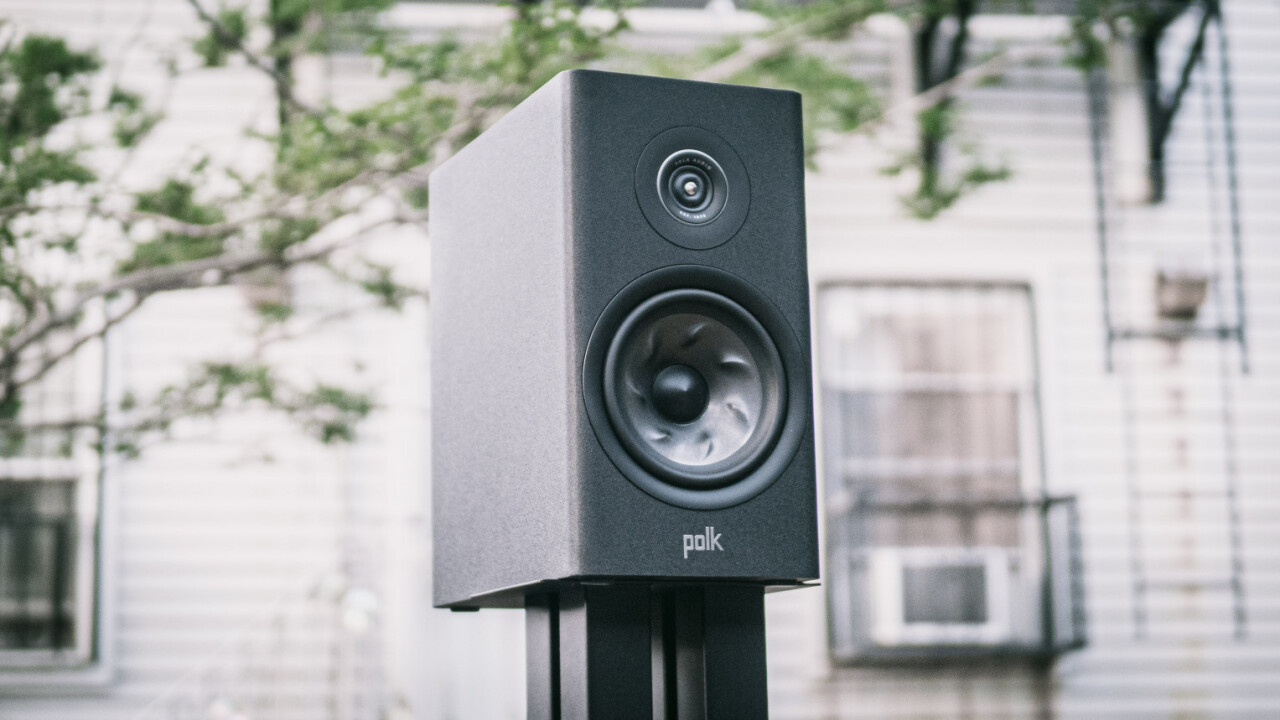
Polk Audio, the American speaker company known for making hi-fi speakers at non-absurd prices, announced the Reserve series back in March. Shortly thereafter reviews flooded the web singing the speakers’ praises, particularly their bang for your buck.
Naturally, I had to get my hands on a pair myself to see what all the hype was about — and put the speaker through the test bench. I chose the Reserve R200, the $700/pair bookshelf model with a 6.5-inch woofer. While $700 may not sound all that cheap to people who aren’t into speakers, it’s basically a budget speaker when you consider most of the really good options retail for closer to $2000.
As TNW’s resident audio nerd, I need to see the data behind a speaker before I’m confident making a recommendation. If you’ve read my post on why speaker measurements matter, then you know that listening impressions can be fickle things, easily affected by biases and expectations. Having been an audiophile for a decade or so now, I know that reviews tend to become more positive in proportion to a speaker’s price. Unfortunately, sound quality and price barely have any correlation.
That’s why I’m always excited to see a speaker that punches well above its price class, and the R200 does just that. The R200’s measured performance shows excellent performance by almost any standard, easily going head-to-head with speakers two or three times its price.
It isn’t flawless — few speakers are — but the R200 is a prime example of sensible design decisions to maximize sound quality at a reasonable price. You won’t find crazy newfangled technology or materials here, just carefully thought out engineering.
This isn’t going to be your typical speaker review. Rather than spending 10,000 words describing different facets of the sound — there are plenty of reviewers more eloquent than me out there — I’m going to mainly focus on the data. Still, I should give you a summary of my thoughts before we jump in.
What does it sound like?
I spent about a week listening to the Reserve R200 before I measured them, and my overwhelming impression was that they pretty much disappeared — that they were nearly transparent. It may be the most neutral 6.5-inch bookshelf speaker I’ve heard under $1,000.
They also have a solid bass extension for their size, and their soundstage is pretty great too. It’s not too narrow, not too wide— vocals snap to the center but the speaker throws out a sizeable soundstage without sounding too diffuse. Dynamics are excellent for a bookshelf speaker too, and the R200 can handle volumes louder than I’m comfortable with without a hitch.
It’s just a really good speaker. The R200 isn’t just competing against other sub-$1000 bookshelf speakers; I think its performance is fully comparable to top-of-the-line $2,000-ish speakers like the KEF R3 and JBL HDI-1600 — and it’s certainly the better value. My benchmark for performance-per-dollar has long been the $1000/€700 Focal Chora 806, but the R200 gives that a run for its money too.
Sound aside, I also appreciate the understated, fairly minimalistic design. The matte black review unit I received is perhaps a little plain, but the white and wood finishes look classy and a bit more modern. Keep in mind the speaker is quite deeper than it looks in photos, about 14 inches.
What, that’s it?
Yep, that’s pretty much all you need to know. Although we reviewers often like to shower compliments on speakers we like, I’ve increasingly found the best speakers aren’t the ones worth the most praise, but rather the ones that have the fewest flaws.
The R200 has very few flaws that I could hear in my setup. But sure, I can nitpick a bit.
The R200 might sound a little bright if you aim it right at your ears, especially if you’re young and still have all your hearing left. It also can be slightly more finicky about positioning than some of the very best speakers I’ve tested, as the sound can change fairly noticeably depending on how the speaker is angled. But aim the tweeter at ear height and slightly away from your listening position — about 10-20 degrees off-axis, perhaps pointing straight forward — and you’re good to go.
The speaker might also sound ever so slightly forward with some vocals, but I personally like the effect on most tracks. And though it has a bit more bass extension than average, it’s nothing like you might find on a DSP-enabled speaker like the (much more expensive but similarly sized) Buchardt A500. As always, you might have to experiment with positioning to find the best bass balance in your room, or better yet, use a subwoofer and Room EQ.
But again, that’s all quite nitpicky.
Alright, get to the graphs already. I know you want to.
If you want to make a speaker that will sound great to most people, there are two things you really need to optimize: frequency response and directivity. The frequency response tells us the basic tonal balance of a speaker before the influence of reflections, and it should be mostly flat. The directivity tells us how that frequency response changes in different directions; the speaker should change smoothly as you move off-axis.
The directivity is important because the reflections off your walls, floor, and ceiling all contribute to the final sound you hear in your room. If you want a speaker to sound really good — to create that realistic soundstage that makes it feel like you’re watching a live performance — then the reflections off your wall should be similar to the direct sound.
We can figure all that stuff out by creating a graph called a spinorama. I capture the speaker’s response at 70 (not a typo) horizontal and vertical angles and combine all that information into one graph. Behold:
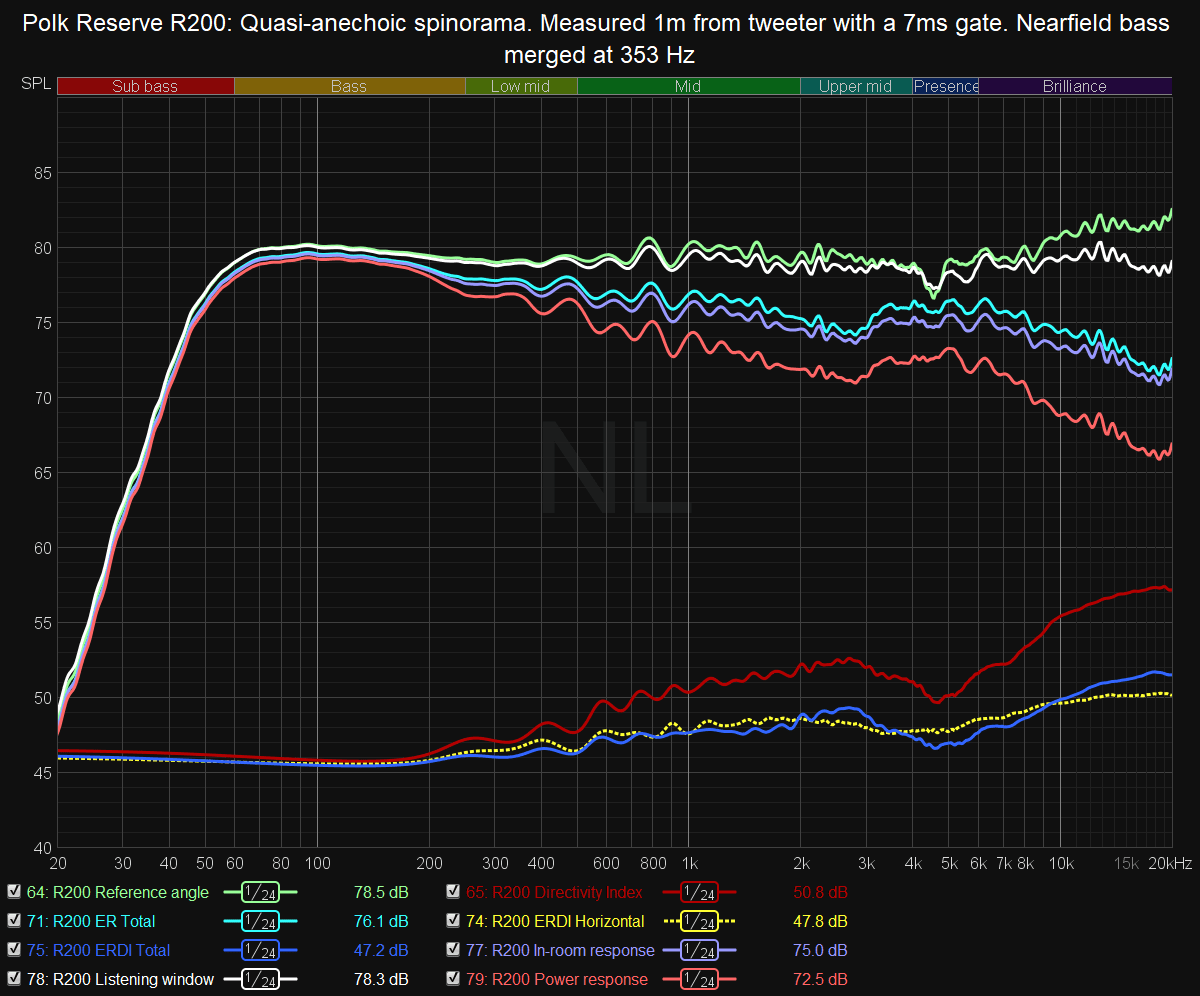
I explain what all of this means in the spinorama section of my measurements guide, but we can focus on a few key things here.
See the white and green lines above? Those represent the frequency response of the ‘direct’ sound — before reflections — with the green line being the ‘on-axis’ response and the white being the ‘listening window.’
The on-axis line shows off what the speaker sounds like when the speaker is aimed exactly at you (in this case, at tweeter height). The listening window gives us a small average of a few horizontal and vertical angles to account for the fact that people don’t sit perfectly centered in front of a speaker all the time, and that you might not aim the speakers directly at your listening position. It is usually the more representative curve for what you hear in a living room setup, so that’s what I tend to focus on.

Here the R200 shines: it is ridiculously flat. The listening window is one of the flattest I’ve measured, especially for a speaker without any kind of DSP processing to help it out.
It’s the type of performance you’d expect from a high-end studio monitor, not a $700 pair of speakers from a fairly mainstream audio company. The rise in the last bit of the on-axis does tell us that the R200 may sound a little bright when listened to head-on, but you can simply point the speakers slightly away from you — about 10-20 degrees seems optimal — to balance out the sound.
Next, we can look at the purple line. This is the ‘predicted in-room response.’ It applies different weights to each of the 70 angles measured to estimate what the speaker’s response will be like in a typical living room (yes, living rooms vary a lot, but it’s still a surprisingly good metric).
We want this line to be flattish too, except with a downward tilt:
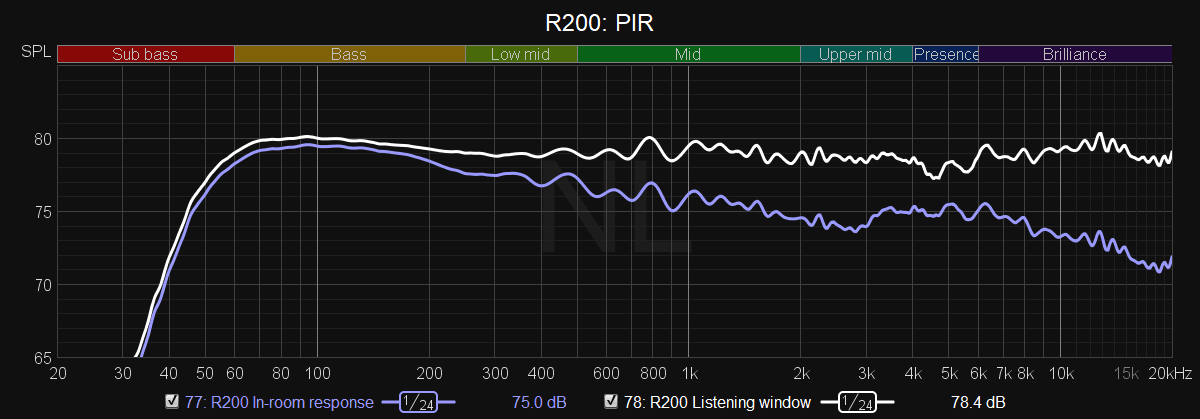
Here the R200 also shows very good performance. There’s a bit of a dip around the 3 kHz crossover —where the woofer hands off the sound to the tweeter — but this is common among speakers with separate woofers and tweeters. The R200 performs almost as good as any speaker I’ve measured on this metric as well.
With just these two lines, we know the R200 is very likely going to have a neutral, largely balanced tonality in most rooms. It’s good stuff.
The bottom red (directivity index or DI) and blue (early reflections directivity index or ERDI) curves summarize the speaker’s directivity. These would ideally be a smooth rising line, so they are not exactly great on the R200.

However, they consider both a speaker’s vertical and horizontal response. While the R200 has a flawed vertical response (again, like most speakers), it has a good horizontal response, which is far more important for creating a good soundstage. The yellow line above isolates just the horizontal portion of the ERDI, and we can see this line is much smoother. That tells us that the speaker will likely have a good soundstage even though its vertical response may be finicky.
This spinorama also tells us that the R200 appears to be mostly free of major resonances that color the sound; this would show up as a bump that stands out in each of the top curves, and can contribute to a speaker sounding boomy or having a grating sound at specific frequencies. Knowing for sure would require an anechoic chamber or advanced tools I don’t have access to, but within the resolution of my system, the R200 performs admirably.
For comparison, here’s how the $1,800 JBL HDI-1600 performs:
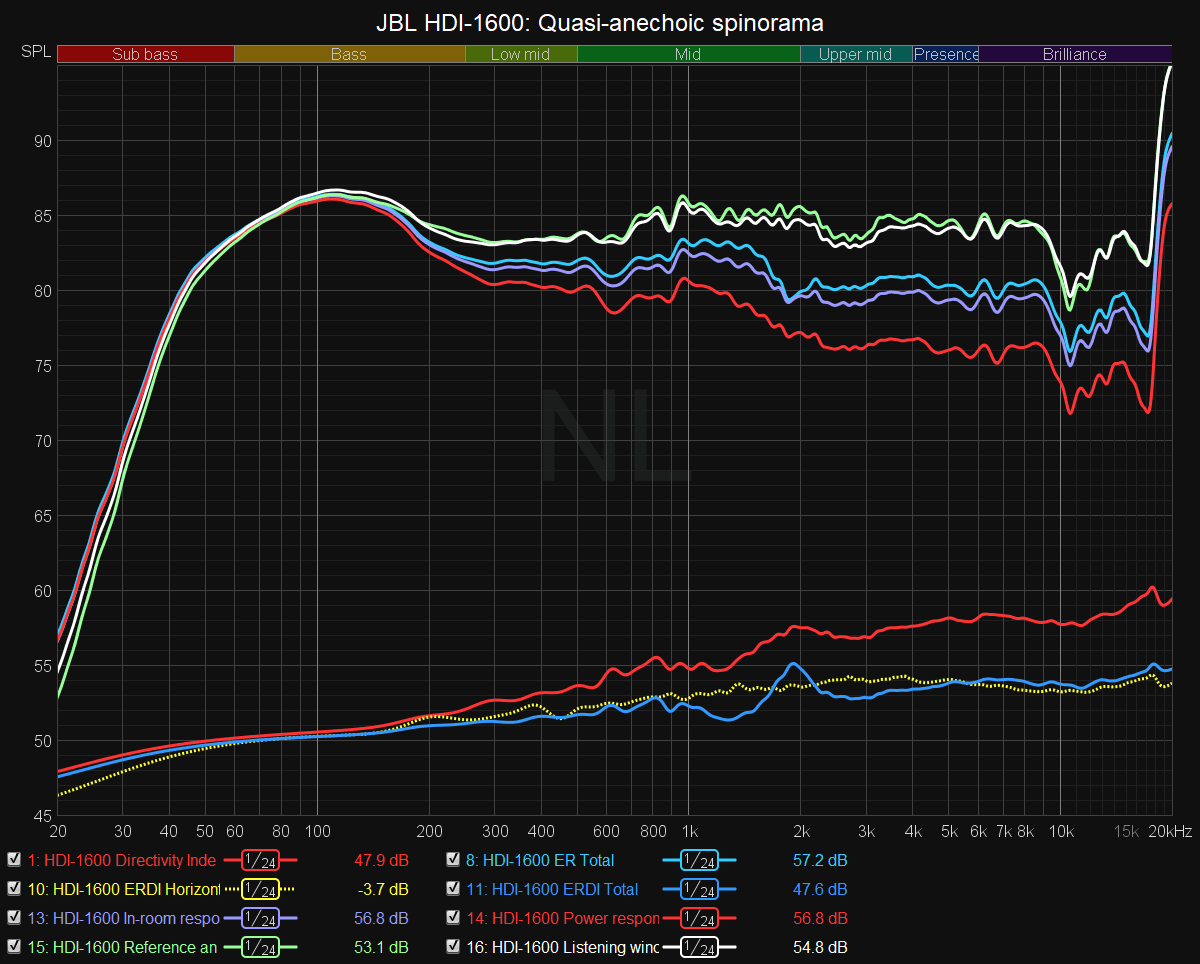
While the JBL has a bit better overall directivity, its response is also less linear than the R200’s.
The spinorama gives us the big picture, but we can get a bit more granular using. For example, we can further break down the horizontal response by checking out what the reflections off the walls in front, to the sides, and behind the speaker might look like:
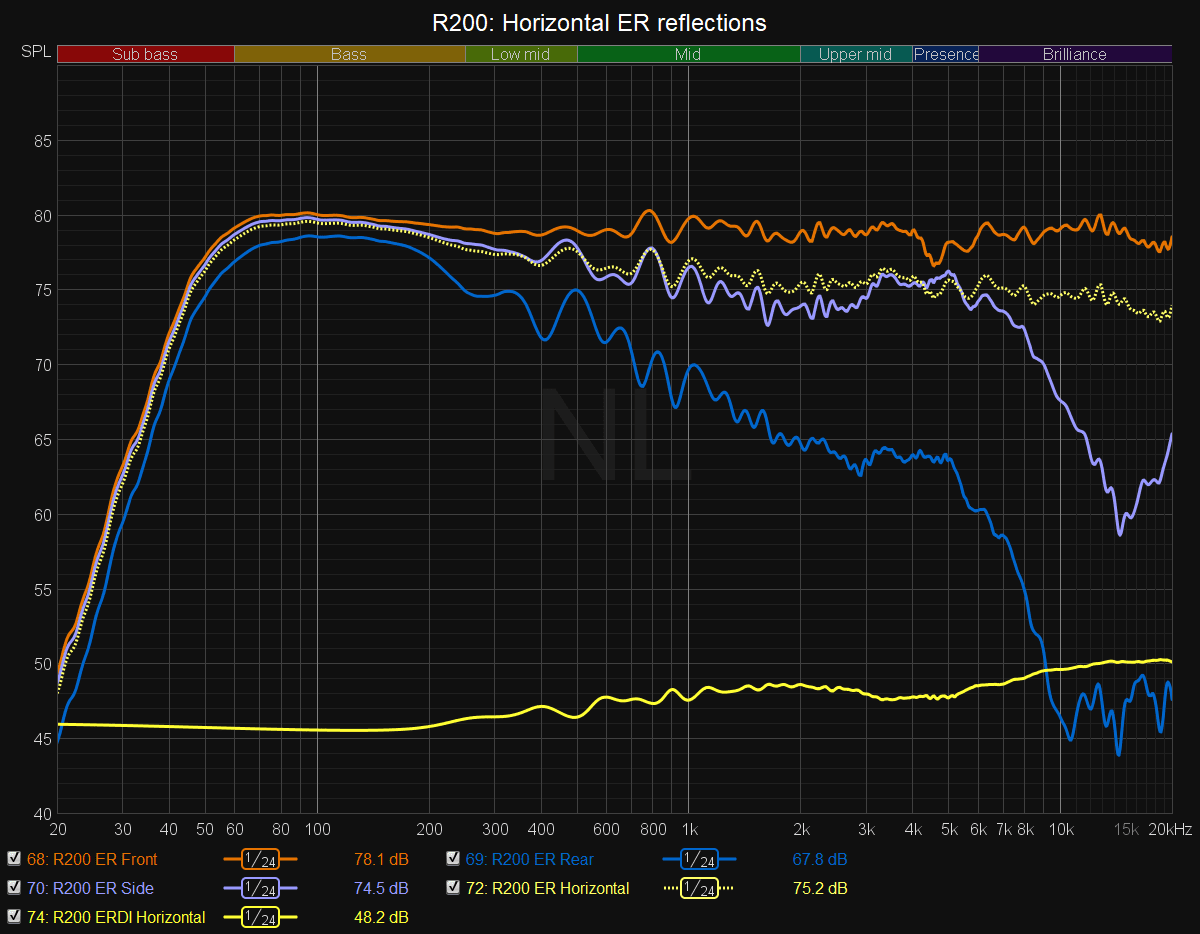
There’s a little bunching around 3-5kHz for the sidewall reflections, which may be why I found vocals to sound a tad forward, but you can see the total horizontal reflections balance out nicely to a linear response in the dotted yellow line.
Breaking things down further, we can see how the R200’s response changes in 10-degree increments horizontally:
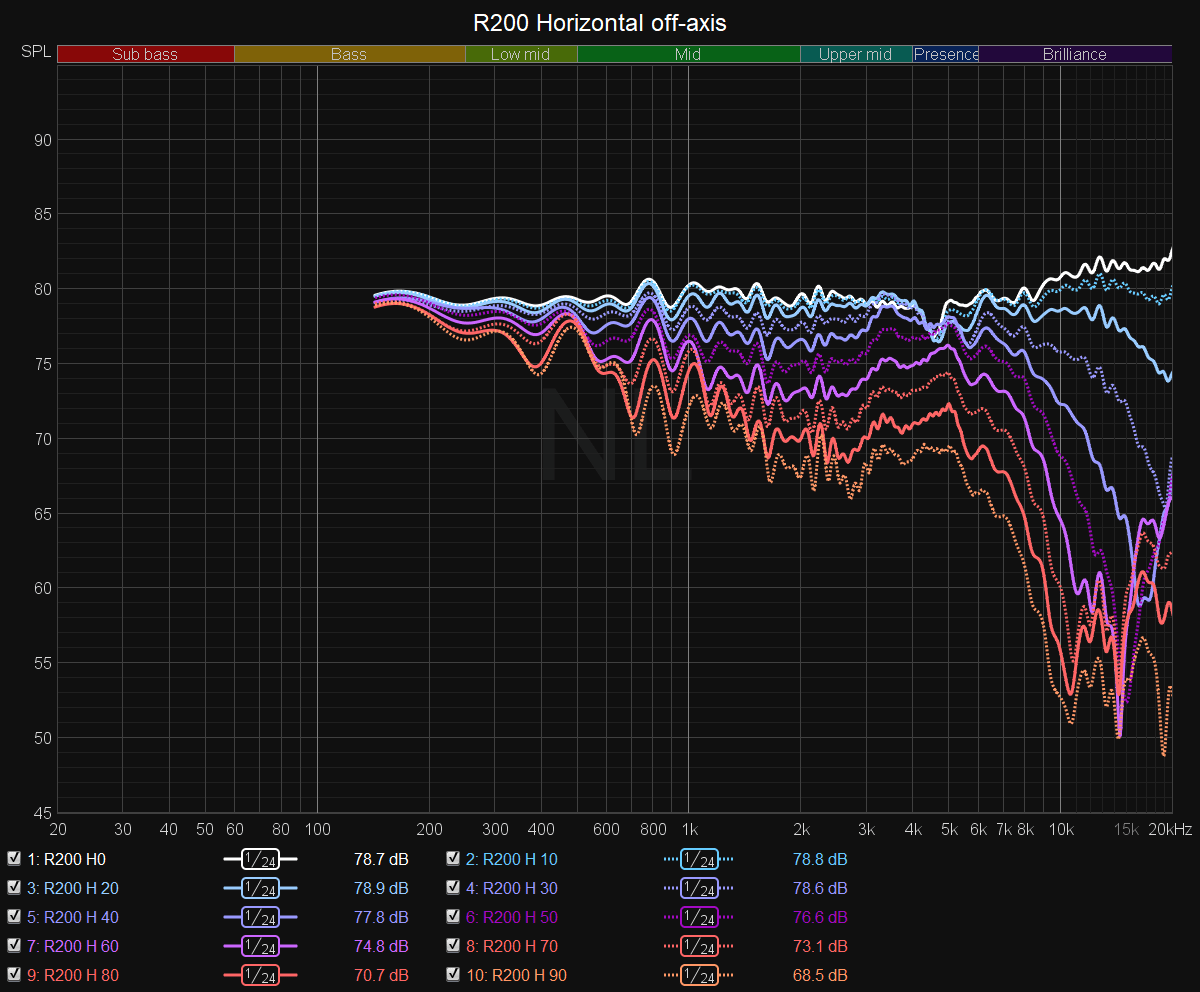
In this graph, you can see how by 10-20 degrees off-axis, that little bit of brightness at the top of the speaker’s response has largely flatted out; if you want the flattest response, you should probably listen about 15 degrees off-axis. You can also see that above 6kHz, the tweeter’s response drops off steeply, which may be why the speaker can be a bit sensitive about positioning. On the other hand, it also means you can ‘tune’ the speaker’s brightness to your taste with positioning.
This isn’t the cleanest horizontal directivity I’ve ever seen, but the vast majority of the speakers that perform better have a narrower soundstage. There’s usually a trade-off between soundstage width and precision, and the R200 toes the line expertly. Among wider directivity speakers I’ve tested, only the Focal Chora 806 performs better.
Now we turn to the biggest flaw on the R200 (and most other speakers): its vertical response. First, we can see that the speaker is quite sensitive to being at the perfect ear height.

Ideally, the tweeter should be at just about ear height, within ±5 degrees. Being 10 degrees above or below the tweeter may noticeably alter the sound. That shouldn’t be an issue for most setups, but it’s worth noting if you can’t set your speakers up at ear height or if you listen to the speakers from less than 2m or 6 feet.
Next we can look at the estimated vertical reflections.

We can see some vertical dips, as is typical for speakers with separate tweeters and woofers. This is the portion that messes up the speaker’s response the most. Luckily, the vertical response doesn’t have a major effect on the soundstage, and despite these results, the end result is still very balanced, as shown with the predicted in-room response, so I wouldn’t worry about these anomalies too much.
That said, it does mean that the R200’s sound might vary a little more from room to room than speakers with better-controlled verticals. Whhile hear the presence bump as forward vocals, you might hear a recession where the response dips. Polk might’ve been able to improve the vertical response by using a larger waveguide that would allow for a smoother transition between the woofer and tweeter, but that might’ve had the sometimes negative effect of narrowing the soundstage too. While the vertical response is a notable flaw, it’s unlikely to be a major issue in most setups.

All these words are just to reiterate the headline; the Polk Reserve R200 is not just a fantastic deal — it’s a really solid speaker at almost any price. Though no one can guarantee you’ll like a speaker, I can at least tell you that you’re getting more than your money’s worth with the R200. Its refreshing to see such thoughtful engineering on a speaker in this price range.
And yes, I’d bet that you probably will like it. A lot. It has my fullest recommendation — especially considering it probably won’t burn a hole in your wallet.
Get the TNW newsletter
Get the most important tech news in your inbox each week.






